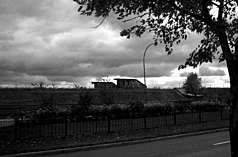Victoriatown, Quebec: Difference between revisions
→History: moved image |
moved image again |
||
| Line 78: | Line 78: | ||
}} |
}} |
||
'''Victoriatown''' (commonly referred to as '''Goose Village''') was a neighbourhood in [[Montreal]], [[Quebec]], [[Canada]]. |
'''Victoriatown''' (commonly referred to as '''Goose Village''') was a neighbourhood in [[Montreal]], [[Quebec]], [[Canada]]. |
||
[[Image:Victoriatown Big Black Rock.jpg|thumb|upright|left|The famous Big Black Rock, commemorating the 5,000 immigrants lost to "ship fever" on their journey.]] |
|||
==Location== |
==Location== |
||
Goose Village was located within [[Pointe-Saint-Charles]] in the [[Le Sud-Ouest|southwest]] borough. The [[neighbourhood]] was just off the [[Victoria Bridge (Montreal)|Victoria Bridge]] (from which it draws its official name) near the [[Old Port of Montreal|Old Port]] and the [[Griffintown]]. The community encompassed six streets in what is now a bus station and parking lot. There were six streets in the town, and all were named after various bridges designed by the principal engineer of the [[Victoria Bridge, Montreal|Victoria Bridge]], [[Robert Stephenson]].<ref name="Gaz"/> |
|||
==History== |
==History== |
||
Revision as of 02:43, 22 January 2008
Victoriatown | |
|---|---|
 Old Victoriatown train station, today. | |
| Nickname: Goose Village | |
| Country | Canada |
| Province | Quebec |
| City | Montreal |
| Population (1963)[1] | |
| • Total | 1,500 |
Victoriatown (commonly referred to as Goose Village) was a neighbourhood in Montreal, Quebec, Canada.

Location
Goose Village was located within Pointe-Saint-Charles in the southwest borough. The neighbourhood was just off the Victoria Bridge (from which it draws its official name) near the Old Port and the Griffintown. The community encompassed six streets in what is now a bus station and parking lot. There were six streets in the town, and all were named after various bridges designed by the principal engineer of the Victoria Bridge, Robert Stephenson.[2]
History

Goose Village was a working-class immigrant neighbourhood of 1500 people. When the community was first established, around 1860, the population was mostly English. However, by 1960, most of the residents were Italian Canadians.[3] Thousands of Irish immigrants living in the area died of typhus during the construction of the Victoriatown Bridge. A giant black rock was erected in their memory. [1]
The quaint village included St. Alphonsus School, Piche's store, and a local cafe that served what was widely regarded as the best fish and chips to be found in the larger metropolitan area of Montreal. Bus no. 2A, driven by Roland ("Flirt") Desourdie, served the community, which was home to over 300 families. Greater Montreal was preparing for Expo 67, leaving the fate of the village — deemed an embarrassment by the city of Montreal and mayor Jean Drapeau — in doubt. Campaigns were undertaken to save the village, but behind the scenes political maneuvers had doomed the town from the start.[2]
The town was simply bulldozed in 1964, leaving only the fire station, train station, and a historical marker (Pictured, at right) to note the passing of a proud community. The decision to raze the community put the many families out of their residences, consigning the history of the village to memories of those who once called it home.[2] Many of the razed homes had been built in Victorian style, but this alone was not enough to save them from the demolition.[1]
After the demolition

Goose Village has been referred to as "sacred" and "special" by former residents. Joe Berlettano, who led the Victoriatown Boys Club in the village from 1955-1960 referred to the small-town culture of Goose Village as "just a beautiful environment." Another former resident, Linda Frannetti, when asked whether she would return to live in the village if she could answers, "Everybody says the same thing: We'd all go back."
Ironically, the Autostade — a football stadium erected for Expo 67 on part of the eight hectares where Goose Village had stood — was itself torn down in the late 1970s. Today this area is mostly uninhabited, containing light industry, a Costco, a train station parking lot, and undeveloped land.[2]
See also
References
- ^ a b c Poddubiuk, Mark. Goose Village. 1983
- ^ a b c d 'V' is for Vanished: Not a trace survives of glorious Goose Village Marian Scott, Montreal Gazette, July 18 2007, Retrieved on 2008-01-16.
- ^ Griffintown and Point St Charles, Quebec Heritage Web accessed 20 January 2008
